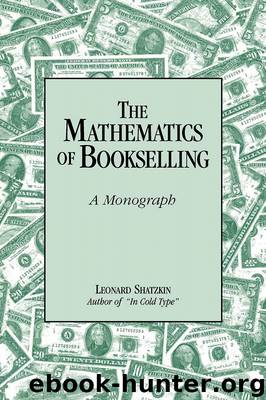The Mathematics of Bookselling by Leonard Shatzkin

Author:Leonard Shatzkin [Shatzkin, Leonard]
Language: eng
Format: epub
Publisher: Sun River Press
Higher Stock Turn:
Moving Toward That Goal
Most booksellers do not bother to calculate stock turn, so it seems odd to be promoting it as the guide for sound buying policy. Fortunately, improving stock turn is not as complicated a process for books as it may be for other merchandise. The key is buying more frequently in smaller quantities. That suggests a greater reliance on wholesalers.
If stock turn is so important, how do you get a higher stock turn?
Stock turn, after all, is not immediately apparent (like discount) when the order for the books is placed. Stock turn can be calculated only after the books are sold. What can you do at the earlier buying step that will assure a higher stock turn at the later selling step?
Some textbooks on retailing will tell you that you have to narrow down the spread of merchandise in the store— carry fewer titles—cutting out the ones that sell more slowly. This suggests that you have to accept lower income to get higher stock turn.
Don’t you believe it!
That may be true for some types of retailers—but it is not true for any bookstore we know about. If you are a superstore carrying 180,000 titles to prove you are macho or to knock out a competitor, the last 80,000 may not be doing your stock turn any good. But that is not where the problem of low overall stock turn lies with most booksellers. Stock turn usually suffers because the bookseller does not use the leverage for higher turn inherent in the fast sellers.
Just take a lesson from our Booksellers Able and Balky. Buy bestselling titles in small quantities—even smaller and more often than Bookseller Balky did—and your average stock turn will climb fast. Balky bought once a month and ran rings around Able. Any bookseller can buy more often than that.
Of course, every store is different and, in a practical sense, frequency of buying depends somewhat on the size and nature of the store; but, in my opinion, most booksellers can cover a major portion of their stock needs buying daily—mostly the bestsellers. Small stores may not be able to meet the wholesaler’s minimum practical order requirement of 50 or 100 copies daily, and may prefer to buy every second or third day, depending on the season. The important thing is finding the shortest practical interval for orders for your store—and it may change from time to time.
Perhaps 95 percent of the titles in inventory are stocked in single copies, with that copy being sold, unpredictably, in three months or eight months or not at all. Daily buying skips almost all of those titles, because when one copy is on hand, no order is required. Such a title will only be included in the daily shopping list when that copy is sold, if then.
Although most booksellers buy every day, they buy for a longer term, tying up more money on each title than they need to tie up—thereby losing the advantage of buying every day. Buying
Download
This site does not store any files on its server. We only index and link to content provided by other sites. Please contact the content providers to delete copyright contents if any and email us, we'll remove relevant links or contents immediately.
| Biomathematics | Differential Equations |
| Game Theory | Graph Theory |
| Linear Programming | Probability & Statistics |
| Statistics | Stochastic Modeling |
| Vector Analysis |
Weapons of Math Destruction by Cathy O'Neil(5038)
Factfulness: Ten Reasons We're Wrong About the World – and Why Things Are Better Than You Think by Hans Rosling(4022)
Factfulness_Ten Reasons We're Wrong About the World_and Why Things Are Better Than You Think by Hans Rosling(2754)
Descartes' Error by Antonio Damasio(2733)
A Mind For Numbers: How to Excel at Math and Science (Even If You Flunked Algebra) by Barbara Oakley(2691)
TCP IP by Todd Lammle(2641)
Applied Predictive Modeling by Max Kuhn & Kjell Johnson(2480)
Fooled by Randomness: The Hidden Role of Chance in Life and in the Markets by Nassim Nicholas Taleb(2413)
The Book of Numbers by Peter Bentley(2404)
The Tyranny of Metrics by Jerry Z. Muller(2401)
The Great Unknown by Marcus du Sautoy(2186)
Once Upon an Algorithm by Martin Erwig(2149)
Easy Algebra Step-by-Step by Sandra Luna McCune(2117)
Practical Guide To Principal Component Methods in R (Multivariate Analysis Book 2) by Alboukadel Kassambara(2093)
Lady Luck by Kristen Ashley(2073)
Police Exams Prep 2018-2019 by Kaplan Test Prep(2034)
Linear Time-Invariant Systems, Behaviors and Modules by Ulrich Oberst & Martin Scheicher & Ingrid Scheicher(1983)
All Things Reconsidered by Bill Thompson III(1960)
Secrets of Creation, Volume 1: The Mystery of the Prime Numbers by Watkins Matthew(1865)
